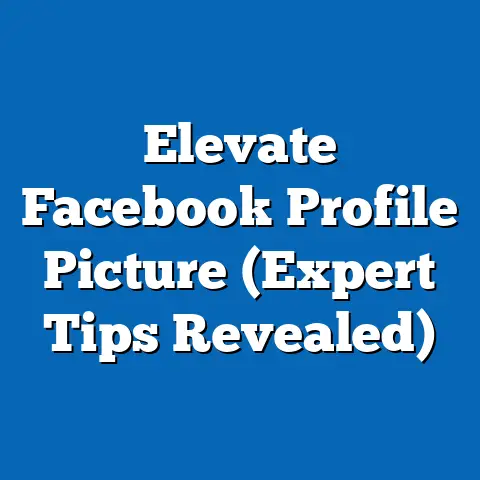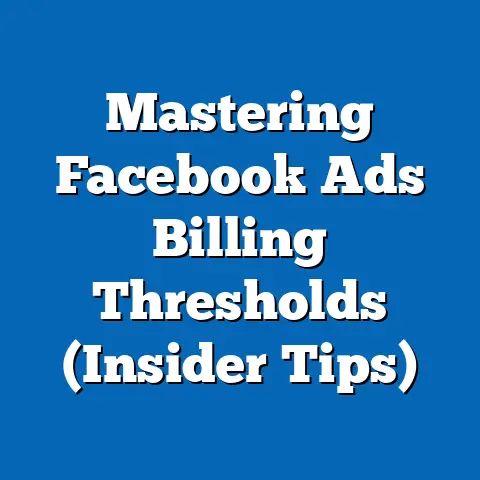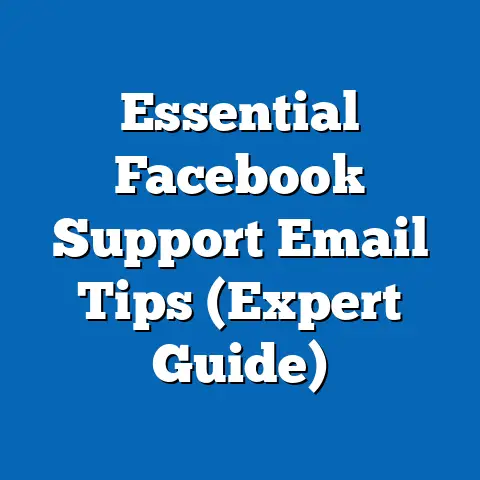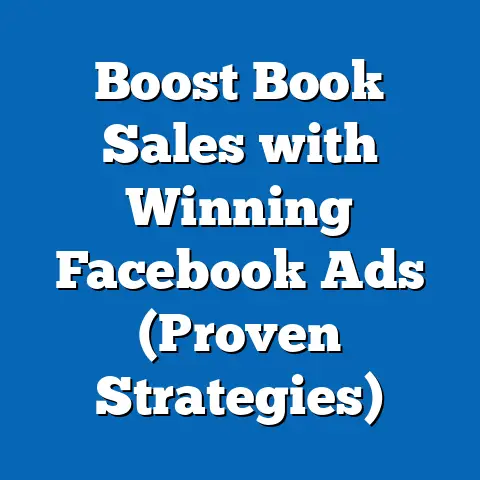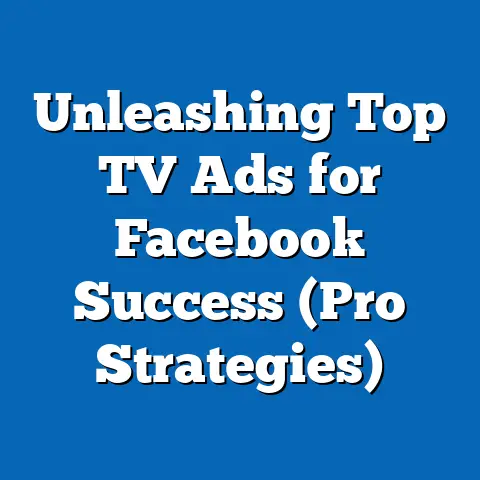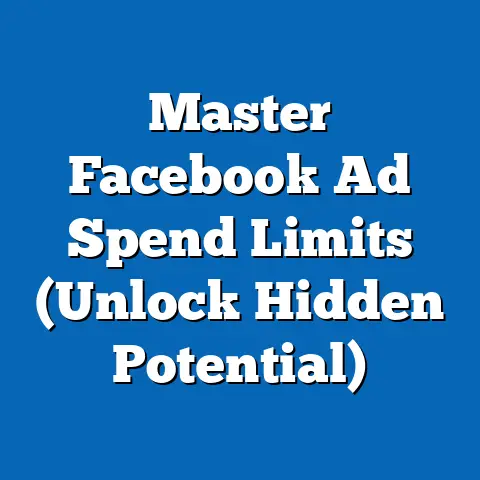Maximize iOS 17 Facebook Ads (Expert Strategies Unveiled)
Understanding the iOS 17 Impact on Facebook Advertising
iOS 17 has brought several changes that directly impact how we advertise on Facebook. The biggest shift is undoubtedly the increased emphasis on user privacy. Apple has doubled down on features like App Tracking Transparency (ATT), which requires apps to obtain explicit permission from users before tracking their activity across other apps and websites.
What does this mean for advertisers?
Well, for starters, it means that the pool of users who allow tracking has shrunk. This directly affects the accuracy and effectiveness of audience targeting. The data we once relied on to create hyper-targeted ads might now be limited or unavailable.
But don’t despair! This isn’t the end of Facebook advertising; it’s simply a call to adapt. We need to focus on first-party data, which is the information you collect directly from your customers. This could include email addresses, website activity, and purchase history. By leveraging this data, you can create custom audiences that are less reliant on third-party tracking.
Another significant change is the way iOS 17 handles ad attribution. With less cross-app tracking, it’s harder to accurately measure the impact of your Facebook ads on conversions and sales. Facebook’s Aggregated Event Measurement (AEM) is still a viable solution, but it’s essential to understand its limitations. AEM prioritizes certain events over others, which means you might not get a complete picture of your ad performance.
How does iOS 17 enhance user experience and engagement?
Despite the privacy concerns, iOS 17 also brings improvements that can benefit advertisers. For example, the updated operating system often provides a smoother and more intuitive user experience, which can lead to higher engagement rates. Features like improved video playback and enhanced AR capabilities can make your ads more immersive and captivating.
Key Takeaway: The impact of iOS 17 on Facebook advertising is multifaceted. While increased privacy measures present challenges, they also encourage us to adopt more creative and user-centric strategies.
The Power of Bold Designs in Facebook Ads
In today’s visually saturated world, your Facebook ads need to be more than just informative; they need to be captivating. This is where bold design comes into play. Bold design is about creating visuals that immediately grab attention and leave a lasting impression. It’s about using color, typography, and imagery in a way that’s both striking and memorable.
Why is bold design so important?
Think about your own experience scrolling through Facebook. How many ads do you see in a single session? Probably dozens, if not hundreds. Most of them blend into the background, but some stand out. Those are the ones that use bold design principles.
Color Theory:
Color is one of the most powerful tools in a designer’s arsenal. Different colors evoke different emotions and associations. For example, red is often associated with excitement and urgency, while blue conveys trust and stability. When choosing colors for your Facebook ads, consider your brand identity and the message you want to convey.
Typography:
Typography is another critical element of bold design. Choose fonts that are easy to read and visually appealing. Experiment with different font sizes, weights, and styles to create contrast and hierarchy. Avoid using too many different fonts in a single ad, as this can be distracting and unprofessional.
Imagery:
The images you use in your Facebook ads should be high-quality and relevant to your target audience. Use images that are eye-catching and visually appealing. Consider using images that feature people, as these tend to be more engaging than abstract graphics.
Mobile-First Design:
Since most Facebook users access the platform on their mobile devices, it’s essential to design your ads with mobile in mind. This means using a vertical or square aspect ratio, keeping text concise, and ensuring that your call-to-action is easily visible.
Tips for Creating Ads That Stand Out:
- Use bright, contrasting colors: Make your ads pop by using colors that stand out from the Facebook feed.
- Incorporate bold typography: Use fonts that are easy to read and visually striking.
- Use high-quality images: Avoid blurry or pixelated images.
- Keep it simple: Don’t overcrowd your ads with too much text or too many elements.
- Test different designs: A/B test different ad creatives to see what resonates best with your audience.
Real-World Example:
One of my favorite examples of bold design in Facebook advertising is the “Dollar Shave Club.” They consistently use bright colors, humorous imagery, and witty copy to grab attention and make their ads memorable.
Key Takeaway: Bold design is essential for creating Facebook ads that stand out in a crowded feed. By using color, typography, and imagery strategically, you can capture attention and drive engagement.
Expert Strategies for Crafting Effective Facebook Ads on iOS 17
Now that we understand the importance of bold design and the impact of iOS 17, let’s dive into some expert strategies for crafting effective Facebook ads:
1. Leverage First-Party Data:
As mentioned earlier, first-party data is more critical than ever. Use your customer data to create custom audiences that are highly targeted and relevant. This could include email lists, website visitors, and purchase history.
2. Create Lookalike Audiences:
Once you have a solid base of first-party data, use it to create lookalike audiences. Facebook will analyze your existing customers and find users who share similar characteristics. This is a great way to expand your reach and target new customers who are likely to be interested in your products or services.
3. A/B Testing:
A/B testing is essential for refining your ad creative and targeting. Test different headlines, images, and call-to-actions to see what resonates best with your audience. Use Facebook’s built-in A/B testing tools to track your results and make data-driven decisions.
4. Optimize for Mobile:
Since most Facebook users access the platform on their mobile devices, it’s essential to optimize your ads for mobile. This means using a vertical or square aspect ratio, keeping text concise, and ensuring that your call-to-action is easily visible.
5. Use Video Ads:
Video ads are highly engaging and can be a great way to capture attention. Use short, visually appealing videos that tell a story and showcase your products or services.
6. Incorporate User-Generated Content:
User-generated content (UGC) is a powerful way to build trust and credibility. Feature customer testimonials, reviews, and photos in your Facebook ads.
7. Target Based on Interests and Behaviors:
Even with the limitations of iOS 17, Facebook still offers a wealth of targeting options. Use interest-based targeting and behavior-based targeting to reach users who are likely to be interested in your products or services.
Case Study:
One of my clients, a local coffee shop, saw a significant increase in sales after implementing these strategies. They started by creating a custom audience based on their email list. Then, they created a lookalike audience to expand their reach. They ran A/B tests on different ad creatives, focusing on mobile optimization and video ads. The results were impressive: a 30% increase in website traffic and a 20% increase in in-store sales.
Key Takeaway: Crafting effective Facebook ads on iOS 17 requires a combination of data-driven targeting, bold design, and continuous optimization. By leveraging first-party data, A/B testing, and mobile optimization, you can maximize your ad performance and drive results.
Ad Formats and Innovations Unique to iOS 17
Facebook offers a variety of ad formats, each with its own strengths and weaknesses. Some ad formats are particularly effective on iOS devices due to their visual appeal and interactive features.
Carousel Ads:
Carousel ads allow you to showcase multiple images or videos in a single ad. This is a great way to highlight different products or features. Carousel ads are particularly effective on mobile devices because they allow users to swipe through the different images or videos.
Video Ads:
Video ads are highly engaging and can be a great way to capture attention. Use short, visually appealing videos that tell a story and showcase your products or services.
Augmented Reality (AR) Ads:
AR ads allow users to interact with your products in a virtual environment. This is a great way to showcase your products and give customers a sense of what it’s like to use them. AR ads are particularly effective on iOS devices because they take advantage of the device’s built-in AR capabilities.
Instant Experience Ads:
Instant Experience ads are full-screen ads that load instantly when a user clicks on them. This is a great way to create an immersive and engaging experience for your audience.
Innovations with iOS 17:
With iOS 17, Facebook has introduced several new features that can enhance your ad formats. For example, the updated operating system offers improved video playback and enhanced AR capabilities. These features can make your ads more immersive and captivating.
Best Practices for Each Format:
- Carousel Ads: Use high-quality images or videos, write compelling headlines and descriptions, and include a clear call-to-action.
- Video Ads: Keep your videos short and visually appealing, tell a story, and showcase your products or services.
- AR Ads: Create a realistic and engaging AR experience, highlight the key features of your products, and make it easy for users to purchase them.
- Instant Experience Ads: Use a full-screen layout, incorporate high-quality images and videos, and create a seamless user experience.
Key Takeaway: Facebook offers a variety of ad formats that are particularly effective on iOS devices. By understanding the strengths and weaknesses of each format and leveraging the latest innovations, you can create ads that are highly engaging and drive results.
Measuring Success: Analytics and Performance Tracking
Tracking the performance of your Facebook ads is essential for understanding what’s working and what’s not. Facebook offers a variety of analytics tools that allow you to track key performance indicators (KPIs) and make data-driven decisions.
Key Performance Indicators (KPIs):
- Reach: The number of unique users who saw your ad.
- Impressions: The number of times your ad was displayed.
- Click-Through Rate (CTR): The percentage of users who clicked on your ad.
- Cost Per Click (CPC): The amount you pay each time someone clicks on your ad.
- Conversion Rate: The percentage of users who completed a desired action, such as making a purchase or filling out a form.
- Return on Ad Spend (ROAS): The amount of revenue you generate for every dollar you spend on advertising.
Using Facebook’s Analytics Tools:
Facebook’s Ads Manager provides a wealth of data about your ad performance. You can track your KPIs, analyze your audience demographics, and see how your ads are performing on different devices.
Interpreting Data:
When interpreting your data, look for trends and patterns. Are certain ad creatives performing better than others? Are certain audiences more responsive to your ads? Use this information to refine your ad targeting and creative.
Making Informed Decisions:
The ultimate goal of analytics is to make informed decisions that improve your ad performance. Use your data to identify areas for improvement and make adjustments to your campaigns.
Guidelines for Continuous Improvement:
- Set clear goals: Define what you want to achieve with your Facebook ads.
- Track your KPIs: Monitor your key performance indicators regularly.
- Analyze your data: Look for trends and patterns in your data.
- Make adjustments: Refine your ad targeting and creative based on your data.
- Test new strategies: Experiment with different approaches to see what works best.
Key Takeaway: Measuring success is essential for optimizing your Facebook ads. By tracking your KPIs, analyzing your data, and making informed decisions, you can continuously improve your ad performance and drive results.
Conclusion
In conclusion, maximizing your Facebook ads on iOS 17 requires a strategic approach that combines bold design, data-driven targeting, and continuous optimization. The increased emphasis on user privacy presents challenges, but it also encourages us to adopt more creative and user-centric strategies.
Remember to:
- Leverage first-party data to create custom audiences.
- Use bold design principles to capture attention.
- A/B test your ad creative and targeting.
- Optimize for mobile devices.
- Track your KPIs and make data-driven decisions.
By staying ahead of the curve and adapting to the evolving advertising landscape, you can drive success with your Facebook ads on iOS 17. So go ahead, experiment with new tactics, and see what works best for your business. The world of Facebook advertising is constantly changing, but with the right strategies and a willingness to adapt, you can achieve your goals and drive results.
I hope this guide has been helpful. Now go out there and create some amazing Facebook ads!

